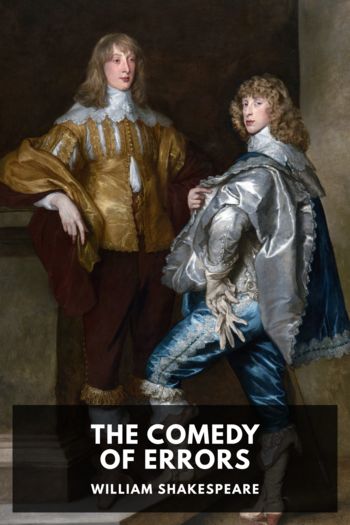The Life of Buffalo Bill, William F. Cody [ebook reader library txt] 📗

- Author: William F. Cody
Book online «The Life of Buffalo Bill, William F. Cody [ebook reader library txt] 📗». Author William F. Cody
Having secured my Indian actors, and along with them Mr. O. A. Burgess, a government interpreter, and Ed A. Burgess, known as the “Boy Chief of the Pawnees,” I started for Baltimore, where I organized my combination, and which was the largest troupe I had yet had on the road; opening in that city at the Opera House, under the management of Hon. John T. Ford, and then started on a southern tour, playing in Washington, Richmond and as far south as Savannah, Georgia, where we were brought to a sudden halt, owing to the yellow fever which was then cruelly raging in the beautiful cities of the “Land of the cotton and the cane.”
While playing in Washington, I suddenly learned from a reporter—Washington newspaper men know everything—that my Indians were to be seized by the Government and sent back to their agency. Finding that there was foundation for the rumor, I at once sought General Carl Shurz, Secretary of the Interior, and asked him if he intended depriving me of my Indian actors. He said that he did, as the Indians were away from their reservation without leave. I answered that I had had Indians with me the year before and nothing had been said about it; but Commissioner Haight replied that the Indians were the “wards of the government,” and were not allowed off of their reservation.
I told the Commissioner that the Indians were frequently off of their reservations out west, as I had a distinct remembrance of meeting them upon several occasions “on the war path,” and furthermore I thought I was benefitting the Indians as well as the government, by taking them all over the United States, and giving them a correct idea of the customs, life, etc., of the pale faces, so that when they returned to their people they could make known all they had seen.
After a conversation with the Secretary of the Interior, the Commissioner concluded to allow me to retain the Indians, by appointing me Indian Agent, provided I would give the necessary bonds, and pledge myself to return them in safety to their agency—which terms I agreed to.
From Savannah, Georgia, having changed my route on account of the yellow fever, I jumped my entire company to Philadelphia, and at once continued on a northeastern tour, having arranged with the well-known author and dramatist, Colonel Prentiss Ingraham, to write a play for me.
The drama entitled The Knight of the Plains, or Buffalo Bill’s Best Trail, was first produced at New Haven, Conn.; it has proved a great success, and I expect to play it in England, where I purpose to go next season on a theatrical tour, having been urged to do so by my many friends abroad.
After a successful tour of six weeks on the Pacific Slope, thus ending the season of 1878–79, I am at my home at North Platte, Nebraska, for the summer; and thus ends the account of my career as far as it has gone.
EndnotesPoor Billy Comstock was afterwards treacherously murdered by the Indians. He and Sharpe Grover visited a village of Indians, supposed to be peaceably inclined, near Big Spring Station, in Western Kansas; and after spending several hours with the redskins in friendly conversation, they prepared to depart, having declined an invitation to pass the night there. It appears that Comstock’s beautiful white-handled revolver had attracted the attention of the Indians, who overtook him and his companion when they had gone about half a mile. After surrounding the two men they suddenly attacked them. They killed, scalped and robbed Comstock; but Grover, although severely wounded, made his escape, owing to the fleetness of the excellent horse which he was riding. This sad event occurred August 27, 1868. ↩
Major North is now my partner in a cattle ranch in Nebraska. ↩
Since traveled with me in my Dramatic Combination as interpreter for Sioux Indians. ↩
Near the lonely camp where I had so long been laid up with a broken leg, when trapping years before with Dave Harrington. ↩
A favorite expression of the Professor’s. ↩
ColophonThe Life of Buffalo Bill
was published in 1879 by
William F. Cody.
Threadable
sponsored the production of this ebook for
Standard Ebooks.
It was produced by
B. Timothy Keith,
and is based on a transcription produced in 2003 by
Papeters, Mary Meehan, and The Online Distributed Proofreading Team
for
Project Gutenberg
and on digital scans available at the
Internet Archive.
The cover page is adapted from
Brigham, the Most Famous Buffalo Horse in the West,
a painting completed in 1916 by
N. C. Wyeth.
The cover and title pages feature the
League Spartan and Sorts Mill Goudy
typefaces created in 2014 and 2009 by
The League of Moveable Type.
The first edition of this ebook was released on
April 20, 2021, 8:39 p.m.
You can check for updates to this ebook, view its revision history, or download it for different ereading systems at
standardebooks.org/ebooks/william-f-cody/the-life-of-buffalo-bill.
The volunteer-driven Standard Ebooks project relies on readers like you to submit typos, corrections, and other improvements. Anyone can contribute at standardebooks.org.
UncopyrightMay you do good and not evil.
May you find forgiveness for yourself and forgive others.
May you share freely, never taking more than you give.
Copyright pages exist to tell you can’t do something. Unlike them, this Uncopyright page exists to tell you, among other things, that the writing and artwork in this ebook are believed to be in the U.S. public domain. The U.S. public domain represents our collective cultural heritage, and items in it are free for anyone in the U.S. to do almost anything at all with, without having to get permission. Public domain items are free of copyright restrictions.
Copyright





Comments (0)